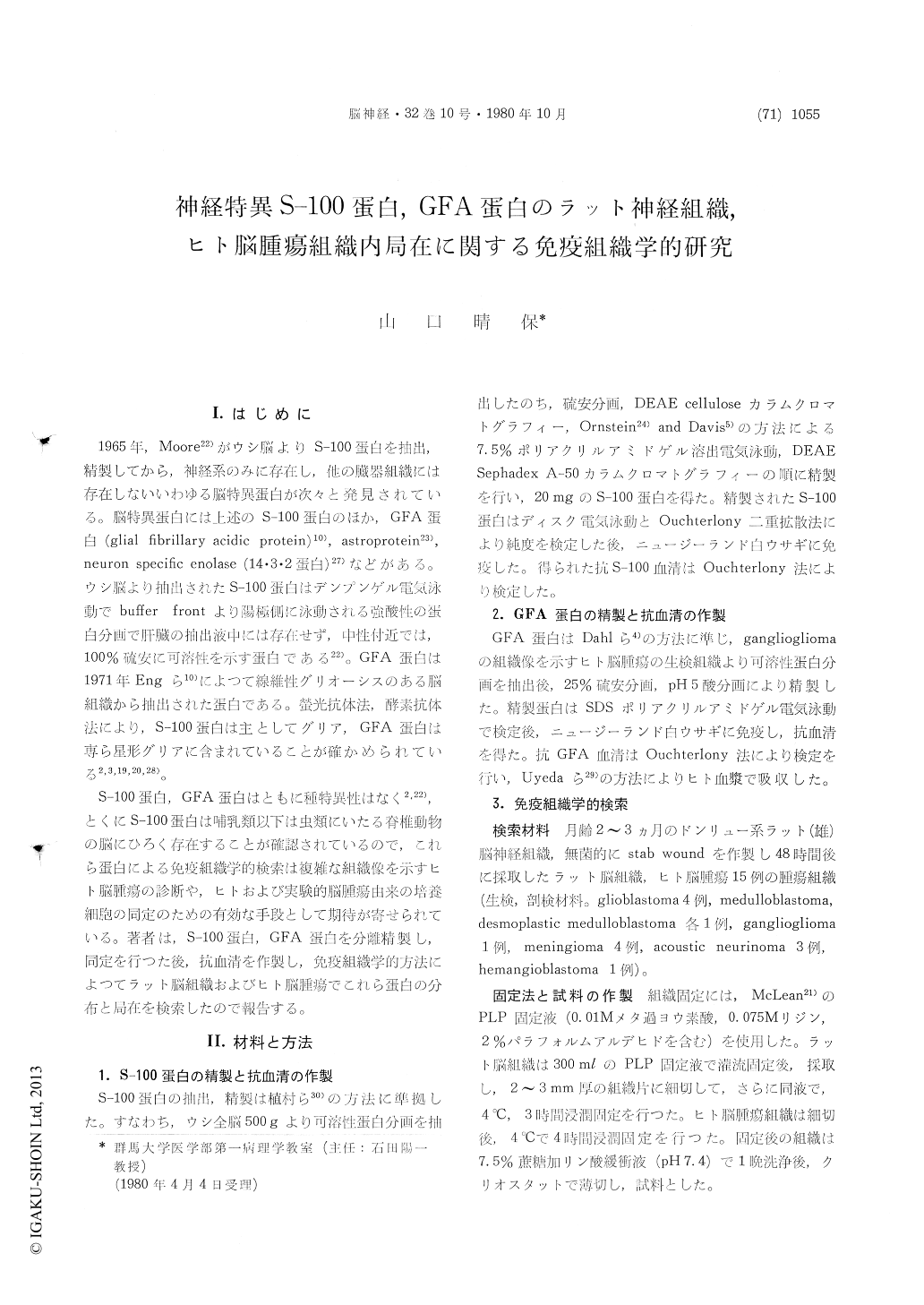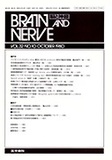Japanese
English
- 有料閲覧
- Abstract 文献概要
- 1ページ目 Look Inside
I.はじめに
1965年,Moore22)がウシ脳よりS−100蛋白を抽出,精製してから,神経系のみに存在し,他の臓器組織には存在しないいわゆる脳特異蛋白が次々と発見されている。脳特異蛋白には上述のS−100蛋白のほか,GFA蛋白 (glial fibrillary acidic protein)10),astroprotein23),neuron specific enolase (14・3・2蛋白)27)などがある。ウシ脳より抽出されたS−100蛋白はデンプンゲル電気泳動でbuffer frontより陽極側に泳動される強酸性の蛋白分画で肝臓の抽出液中には存在せず,中性付近では,100%硫安に可溶性を示す蛋自である22)。GFA蛋白は1971年Engら10)によつて線維性グリオーシスのある脳組織から抽出された蛋白である。螢光抗体法,酵素抗体法により,S−100蛋白は主としてグリア,GFA蛋白は専ら星形グリアに含まれていることが確かめられている2,3,19,20,28)。
S−100蛋白,GFA蛋白はともに種特異性はなく2,22),とくにS−100蛋白は哺乳類以下は虫類にいたる脊椎動物の脳にひろく存在することが確認されているので,これら蛋白による免疫組織学的検索は複雑な組織像を示すヒト脳腫瘍の診断や,ヒトおよび実験的脳腫瘍由来の培養細胞の同定のための有効な手段として期待が寄せられている。著者は,S−100蛋自,GFA蛋白を分離精製し,同定を行つた後,抗血清を作製し,免疫組織学的方法によつてラット脳組織およびヒト脳腫瘍でこれら蛋白の分布と局在を検索したので報告する。
The localization of S-100 and glial fibrillary acidic (GFA) proteins has been studied immuno-histochemically in sections from adult rat nervous system and human brain tumors.
The S-100 protein used in this study was ex-tracted and purified from bovine brain by a modi-fication of the procedure of Uyemura et al. (1971), and the GFA protein was isolated from a human brain tumor with the histology of ganglioglioma according to the method of Dahl et al. (1973). The antisera against these proteins were prepared in New Zealand white rabbits. The specimens removed from the adult rat nervous system and human brain tumors were fixed with McLean's PLP fixatives and sectioned with cryostat for investigation by immunofluorescence.
The cytological distribution of the S-100 protein in the rat nervous system was examined by directfluorescent antibody technique. Specific fluorescence for S-100 protein was observed in astrocytes, ependymal cells and in some of the interfascicular oligodendroglia. S-100 protein was also found in the nuclei of some neurons (anterior horn of spinal cord, cerebellar nucleus). The cell bodies of these neurons were found to be weakly fluorescent. In trigeminal nerves and ganglia, the S-100 protein was located in cell bodies and nuclei of Schwann cells and mantle cells, and in nuclei of ganglion cells.
The GFA protein was detected in the perikarya of astrocytes and their spider-like processes by indirect fluorescent antibody technique. Bergmann's glial fibers, glial limitans over the surface of the brain and around blood vessels and subependymal glial fiber networks were intensively fluorescent. A part of ependymal cells of the lateral and third ventricles showed specific reaction to GFA protein in their perinuclear cytoplasm. Cerebral macro-phages appearing in the neighborhood of the stab wound, which were positively impregnated with Hortega's method for microglia, were not fluorescent for S-100 and GFA proteins.
An immunofluorescent study with antibodies to S-100 and GFA proteins was carried out on specimens from 15 brain tumors. The materials included 4 glioblastomas, 1 ganglioglioma, 2 medulloblastomas, 4 meningiomas, 3 acoustic neurinomas and 1 hemangioblastoma of the cece-bellum. The S-100 protein was present in glio-blastomas, ganglioglioma and acoustic neurinomas. In glioblastomas, the intensity of specific fluo-rescence of the neoplastic cells for S-100 protein was observed varying considerably from case to case and from cell to cell even in the same tumor. Acoustic neurinomas showed bright fluorescence against anti-S-100 antibody conjugated with FITC.
The positive reaction to GFA protein was demonstrated in cells of glioblastomas and in astrocytic elements of ganglioglioma. The propori-ton of GFA-positive cells in these tumors varied greatly from tumor to tumor. The component cells of a medulloblastoma examined showed weak re-action to GFA protein in their scanty cytoplasm and slender processes. The reaction of these cells to S-100 protein, however, was not detected. In a case of desmoplastic medulloblastoma, cells with positive immunofluorescence for both S-100 and GFA proteins, were found scattered in groups among tumor cells with no fluorescence. It remains to be determined whether the findings in the medulloblastomas would suggest differentiation of undifferentiated neoplastic cells toward glial cells. Hemangioblastoma was negatively stained for these proteins. In 2 of 4 cases of meningioma examined, a small proportion of cells were immunofluorescent for both S-100 and GFA proteins.
It is considered that demonstration of the brain specific S-100 and GFA proteins were useful for exact identification of diagnostically difficult human brain tumors.

Copyright © 1980, Igaku-Shoin Ltd. All rights reserved.


